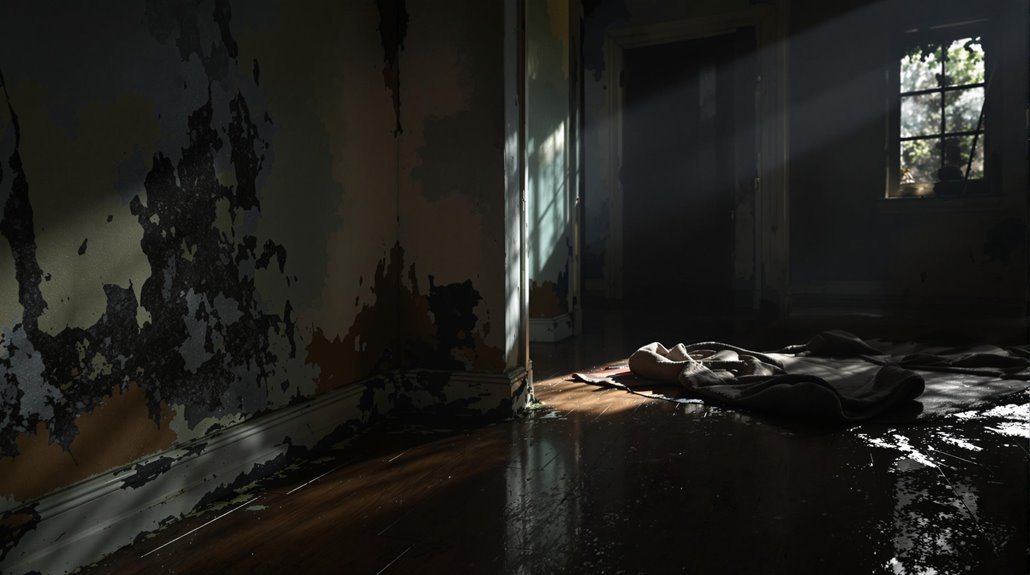You need to watch for key signs of water damage that require immediate restoration. Look for visible indicators like water stains, peeling paint, or bulging walls that suggest moisture intrusion. Pay attention to musty odors, indicating mold or mildew growth, which can pose health risks. Unexpected spikes in water bills may signal hidden leaks needing urgent attention. Furthermore, compromised structural integrity, such as warped wood or cracking walls, is a serious concern. If you notice these issues, it's crucial to act quickly to prevent escalating damage and costs. There's much more you can consider to safeguard your property.
Key Takeaways
- Visible water stains, peeling paint, or discoloration on walls and ceilings indicate moisture intrusion needing urgent attention.
- Musty odors suggest mold growth, which can trigger health issues and requires immediate remediation.
- Structural damage, such as warping or cracks in walls, signals compromised integrity that demands prompt restoration.
- Sudden increases in water bills or unexplained meter readings may indicate hidden leaks needing investigation.
- Standing water or dampness in areas requires immediate drying to prevent further damage and health risks.
Visible Water Damage Indicators

When it comes to identifying water damage in your home, several visible indicators can provide vital insights. One of the most common signs is water stains, which appear as yellow, brown, or dark spots on walls and ceilings. These stains often indicate moisture intrusion, signaling that immediate attention is necessary. Furthermore, you might notice peeling paint or wallpaper; this bubbling or flaking indicates moisture trapped behind the surface, compromising your home's aesthetic and structural integrity.
Discoloration is another significant indicator, with areas of your ceiling potentially turning shades of orange, green, or yellow, further hinting at ongoing moisture issues. If you observe white, chalky deposits on masonry walls, that's efflorescence, a byproduct of water evaporation that leaves mineral residues. Additionally, understanding water damage categories is crucial for determining the appropriate response to the issue. Warping or bulging of walls can likewise suggest trapped water, creating an uneven appearance. Regular monitoring of vulnerable areas is essential to catch issues early and prevent significant damage.
Structural Integrity Concerns
Visible water damage indicators often signal deeper issues within your home's structure. When water infiltrates wooden structures, it compromises their integrity, leading to vulnerabilities like swelling, warping, and rotting. Load-bearing beams and floor joists are particularly susceptible, and prolonged exposure can result in a dangerous weakening of these essential components. If left unattended, this decay may cause structural collapse, posing severe risks to you and your occupants.
Similarly, water exposure affects metal supports. Prolonged moisture can instigate metal corrosion, particularly in steel beams or reinforcement bars. Rust formation diminishes the load-bearing capacity, ultimately threatening the entire structure's strength. Ignoring these metal corrosion impacts can lead to costly repairs or catastrophic failure.
Additionally, water damage can saturate the soil around your foundation, exerting pressure on the walls and potentially causing cracks or shifts. This jeopardizes the stability of your entire home, emphasizing the need for immediate action. Timely water damage restoration is crucial to preserve your home's structural integrity and prevent extensive, costly repairs down the line. Understanding the type of water damage is essential to address these concerns swiftly and maintain a safe and sound living environment.
Unpleasant Odors and Health Risks

Unpleasant odors often signal underlying water damage issues that require immediate attention. If you detect musty smells in your home, it's a strong indicator of mold and mildew growth, thriving in damp environments. Mold infestations can develop within 24 to 48 hours of water damage, making prompt detection vital. Ignoring these odors may lead to significant health risks, as inhaling mold spores can trigger respiratory issues, allergic reactions, and worsen conditions like asthma.
Beyond respiratory complications, exposure to mold can cause skin irritation and gastrointestinal problems because of harmful bacteria in contaminated water. Prolonged exposure to mold and its byproducts compromises your immune system, increasing your susceptibility to infections and chronic health conditions. Additionally, mold releases volatile organic compounds (VOCs) that degrade indoor air quality, leading to symptoms such as headaches and persistent fatigue.
Immediate action is important to mitigate these health risks. Removing standing water, drying affected areas, and dehumidifying spaces should be your top priorities. Engaging professional remediation services guarantees safe restoration of your environment, protecting your health and well-being from the mold risks associated with unpleasant odors.
Unexpected Costs and Utility Changes
Sudden spikes in your water bill can be a telling sign of hidden water damage that needs immediate attention. If you notice water bill anomalies without any change in your consumption habits, it's vital to investigate further. Such increases can lead to significant financial implications if not addressed promptly. Here are four important indicators that may confirm the need for immediate water damage restoration:
- Unexplained Meter Readings: If your water meter shows high readings while all sources are turned off, you might have a leak.
- Continuous Flow: An unnoticed leak can cause continuous water flow, elevating your utility costs dramatically.
- Visible Damage: Stains, warped materials, or mold growth can indicate long-term exposure and escalating repair costs.
- Structural Concerns: Cracks or soft spots in walls and ceilings suggest structural stress, requiring costly repairs.
Ignoring these signs can lead to extensive financial burdens, ranging from repair costs of $500 to $6,000 and increased insurance premiums. Take action now to mitigate these unexpected costs and protect your investment.
Urgent Safety Precautions and Actions

When you find water damage, it's vital to act swiftly to secure your safety and minimize potential hazards. Begin with water source identification; shut off the main valve to halt water flow from any burst pipes or leaking appliances. Next, turn off the electrical power to the affected area to prevent electrical hazards. Assess the water category—clean, gray, or black—to gauge contamination levels, and check for gas leaks to safeguard gas lines.
Your emergency response should include wearing personal protective equipment (PPE) like gloves and goggles to shield yourself from harmful bacteria. Ventilate the space to combat mold growth, and avoid contact with contaminated water to prevent health issues. If necessary, utilize specialized equipment for water extraction, but always consider hiring professionals if the situation exceeds your capabilities.
Notify your insurance company promptly to document the damage. Don't forget to have an electrician inspect your wiring and appliances before restoring power, and confirm that any submerged gas appliances are likewise checked. Taking these urgent safety precautions is vital to protect yourself and your property from further complications.
Conclusion
If you notice any signs of water damage, acting quickly is essential. Delaying restoration can lead to mold growth, which affects approximately 30% of buildings in the U.S. according to the Environmental Protection Agency. Not only can this compromise your home's structural integrity, but it can likewise pose serious health risks to you and your family. Don't wait for minor issues to escalate; prioritize immediate water damage restoration to safeguard your home and well-being.







